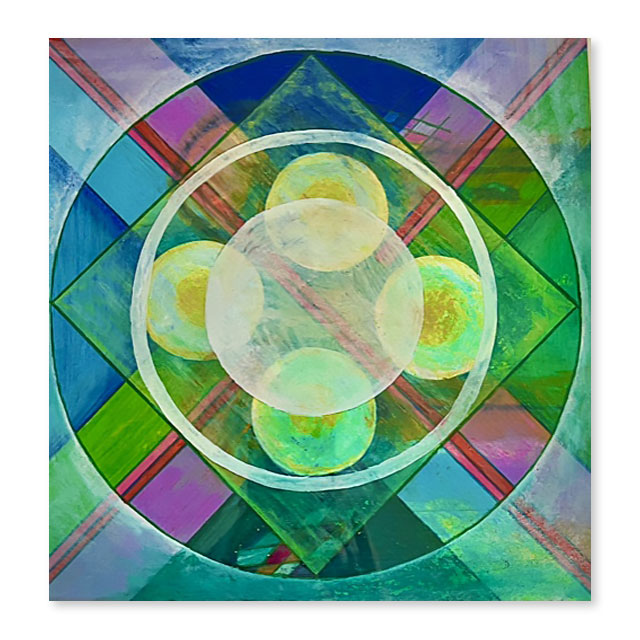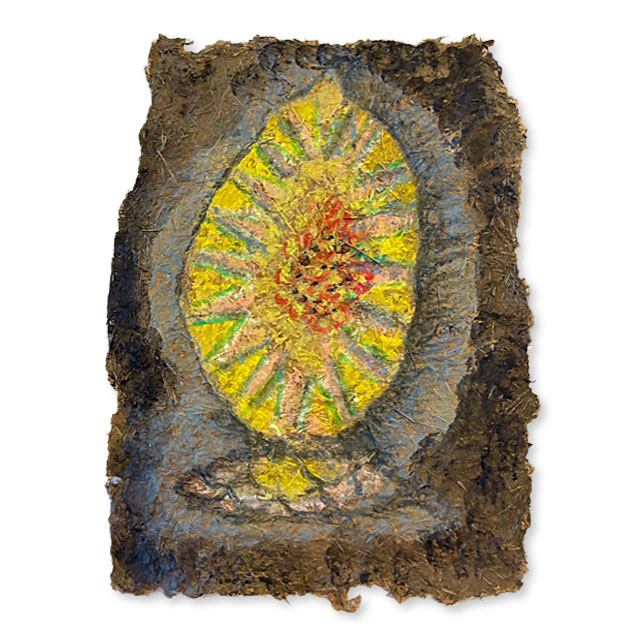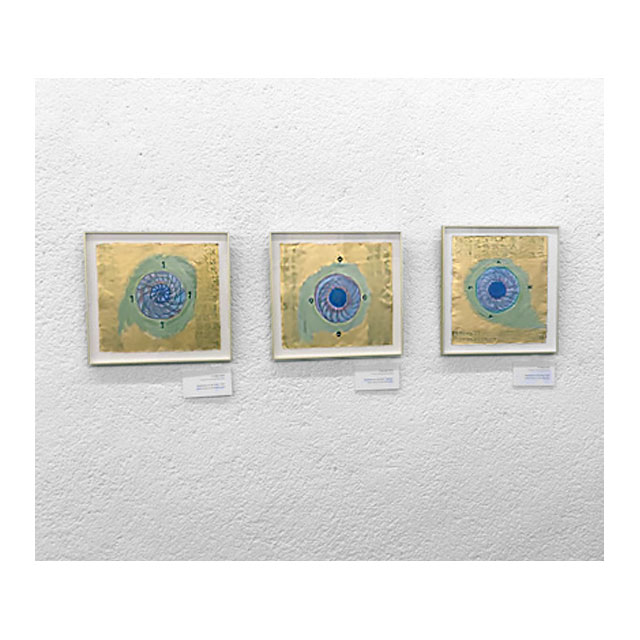Videos
Bruria Finkel: Meditations on the Alphabet
Artist Bruria Finkel on site October 3, 2023 at Henry Crown Gallery, Jerusalem Theatre. Next day the War broke out…
………………….
The video, below, Bruria Finkel: Meditations on the Alphabet is a recorded Zoom event, November 1, 2023, featuring Moshe Idel PhD, Christine Meilicke PhD, Batsheva Goldberg-Ida PhD and Amy Shimshon Santo PhD as we discussed The Prophetic Cabbala and 1960’s Counter Culture in California, where I live.

Jerusalem Theatre, Henry Crown Gallery, October 3 – December 31, 2023
Artist Talk on Kabalah, November 1
Group Discussion (on Zoom) with the artist Bruria Finkel; her daughter, Amy Shimshon-Santo, poet; Prof. Moshe Idel, Professor of Jewish Thought Emeritus at the Hebrew University of Jerusalem; Dr. Christine Meilicke, scholar of contemporary American Jewish literature and culture; and the Jerusalem Theatre curator, Dr. Batsheva Goldman-Ida.
………………….
In the mid-60s of the previous century, artist Bruria Finkel joined a group of poets and visual artists, members of California’s counter-culture movement, such as Jack Hirschman, Jerome Rothenberg, and David Meltzer. Through them, she became acquainted with the linguistic mysticism of Abraham Abulafia, a 13th-century Kabbalist. Finkel was asked to translate into English his tractate “Sefer Ha-Ot” (The Book of the Letter – 1288), and about twenty years later, she began to create – in mixed media – her series “Meditations” displayed in the exhibition.
Square Within the Circle
Golden Aleph
Leaf
Creation of Trees
Kerchief
Meditation on VAV, YOD, SAMECH
Meditation on VAV
Four Corners, Yellow Center Blue, Rare Mandala, Directional
Spheres of Depth
Kerchief
Leaf
VAV Straight Up
Golden Aleph
Meditation on VAV, YOD, SAMECH
Creation of Trees
Four Corners, Yellow Center Blue, Rare Mandala, Directional
Bruria Finkel, Artist
An online presentation by LA artist Bruria Finkel to the members of Southern California Women’s Caucus for Art, October 21, 2021.
Revealed After 47 Years
My friend Isabelle called me and asked if forty-some years ago I had written a poem on the wall of Womanspace on Venice Blvd. in Culver City. I said I think so… it was when we were preparing a storefront that was previously a laundromat into a women’s alternative space in 1972…
Papermaking in Japan
I had never been to Japan and always wanted to visit. My friend Hiromi Katayama invited me to go along with her on a shopping tour – I signed on immediately. We traveled to villages where handmade paper has been in production for the last 1,500 years and met a few of the country’s Living National Treasures – some still on the job and working. It was the trip of a lifetime.
From Jerusalem to Jericho
In 2017 I participated in the Jerusalem Biennale at the Museum of Underground Prisoners in central Jerusalem not far from the wailing wall. For the video I visited Israel in 2016 and traveled to Jericho to photograph the Jordan River flowing into the Dead Sea. The video became part of my Salt Mound exhibition at the Biennale.
Israelis are not allowed to travel to Jericho; my American passport enabled me to do so.
I started using video to record my work and particularly my exhibitions – to keep a record of the process involved and to document the final installation.
In late 1980s I traveled to the Stadtmuseum in Düsseldorf, Germany to create an exhibition: Across Time, Space and the Ages. My intent was to convey the interactions of people sharing ideas, group meditations, historical events and issues of the day.
Beginning with this experience, videos have been made of all my gallery works and become an important part of my process.
The Complete Aleph Series
2009 | (running time: 5:12)
The Complete Aleph Series was inspired by the work of cabalist Avraham Abulafia who lived in Spain in the 13th century; I translated his work from Hebrew to English. One of my works was published and others are awaiting publication.
This series required 24 years to accomplish – its numerous artworks include large bronzes, acrylic work on canvas and paper, gold leaf, video and handmade books.
On Xenophobia and Walls
1997 | (running time: 15:32)
I was invited to create an exhibition at the Mill Gallery in Carlisle, England, the country’s northernmost city adjacent Scotland.
Historically, there has been animosity between the Scottish and the British and I decided to use Hadrian’s Wall – created by the Romans in 180 B.C. to keep the Scottish out – and compare it with the Tijuana Wall in California.
Inside the Mill Gallery I replicated 8 ft. of Hadrian’s Wall with original stones from the wall and interviewed local artists on the issue of xenophobia. At the time, this exhibition was very relevant to Carlisle and local politicians in attendance were actively engaged.
Across Time, Space and the Ages
1992/93 | (running time: 17:50)
In 1991 I was invited to go to Düsseldorf, Germany and create an exhibition at Stadtmuseum Düsseldorf (state museum in Düsseldorf), 1992/93. I decided to create a temporary installation that would involve a healing process associated with the holocaust. I engaged in letter writing with local German artists, (our correspondence is preserved in the exhibition catalog) and when my assistant and I arrived, we drove to Dachau to bring earth from the concentration camp back to Düsseldorf.
The video: Across Time, Space and the Ages is a documentary of this experience including the group mediation that took place at the museum.
Curated Exhibitions
Emphasis Santa Monica
2008 | (running time: 2:39)
Emphasis Santa Monica is focused on contemporary living artists who both live and work in this city. It is an eclectic exhibition. Its intent is to show the variety of work being created NOW.
The work presented in this exhibition is vibrant, good and powerful – a reflection of our community.
Women Artists of Southern California: then & now
2007 | (running time: 5:07)
The emphasis on women artists’ work is important and long overdue. The time period between Then (the 1970s) and Now (2007) defined the formative years of many artists in this exhibition. Each work displayed represented a unique growth experience by the artist or the community’s state of being.
World Artists for Tibet | Human Rights Month
1998 | (running time: 17:31)
This event was part of a worldwide effort on the part of artists to call attention to the state of affairs existing in Tibet at the time.
This video documents an exhibition I curated at the Santa Monica Museum of Art that included local artists I knew who were also strongly committed to Human Rights: Leon Golub, Nancy Spero, John Baldessari, Noah Purifoy, Carl Chew, Wallace Berman and myself.
I invited eleven Drepung Loseling Monks to come to Santa Monica and create a kaalchakra (mandala) for peace. More than 2,000 people participated in the different activities that took place over five days. Community support was exceptional – we housed and fed the monks and participated in their activities.








